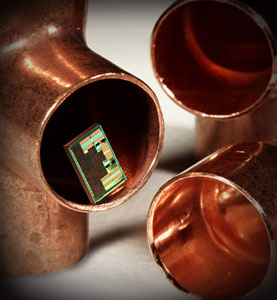Copper Technology: The Link to Cyber Space
Early in the Computer Age, the first general purpose computers weighed about 27 tons and required the equivalent of a small studio apartment to support the thousands of vacuum tubes, crystal diodes, relays, resistors, capacitors and hand-soldered joints that made up the entire system.
Today-more than half a century later-computers are being made smaller, more compact, and designed to work faster in order to suit more mobile tech-savvy customers.
Surfing the Internet, checking e-mails or setting your fantasy sports lineup can now be done from the convenience of a laptop computer, cell phone or iPod Touch hand-held device. And many restaurants, coffee shops and neighborhood parks, like Manhattan's own Bryant Park in Midtown, offer free WiFi access, so customers and visitors alike can sip their lattes or bask in the sun while shopping online or browsing the Web remotely.
 Photo provided by IBM
Photo provided by IBM
High-resolution version of this photo.
One of the elements behind what many believe to be the greatest technological advancement of our time lies in the copper that makes all this conductivity and connectivity possible.
Copper, one of the world's oldest metals known to be used by man, can be found in many of the elements found in the computer, including the integrated circuitry and micro chips that enable it to run faster, stay cooler and store more information in smaller spaces.
Prior to using copper, aluminum had been the metal of choice for semi- conductor wiring. But as the number of transistors used in microprocessors doubled, the chips needed to be made even smaller, while still being able to hold more information. As new materials were introduced to integrate the system onto smaller chips, IBM researchers discovered that copper worked more efficiently and effectively in improving a computer's performance and speed.
Because copper is a superior conductor of electricity, electrical signals can be transmitted faster. And copper's thermal conductivity also plays a role in reducing the heat that is generated by computers.
"Once the industry rallied around copper, it pretty much became the main circuitry component in semi conductors," said Michael Loughran, communications manager for IBM Research in Yorktown Heights, NY. "Look at today's mobile devices, cell phones, and iPods-something of that size would not have been possible a decade ago without the implementation of this technology."
Copper has been used widely for myriad applications. More commonly, copper is found in residential and commercial building and construction projects, serving as an architectural adornment, as well as for plumbing and wiring purposes. Copper typically offers the highest durability among competing materials, which translates into lower maintenance costs-along with green-building advantages of maximum sustainability and recyclability-over a lifetime of installed service.
Copper is also used in automotive technology and other energy-saving products such as direct exchange geothermal heat pumps and solar collectors thanks to the metal's superior conductivity and thermal transfer capability.
"Copper continues to outperform other materials when it comes to developing ways for making our lives easier," said Danielle McAuley, communications manager for the Copper Development Association (CDA. "And as technology advances, we're learning that mankind's first metal is just as valuable today as it was centuries ago." Cu
